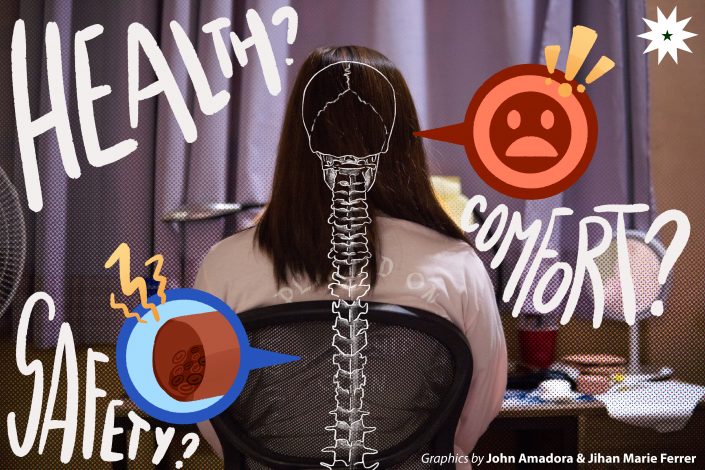“Man will work better if he feels better,” states Dr. Alma Gutierrez—an associate professor from the Industrial Engineering Department. Workspaces are best designed to cater to the needs and capabilities of their users, necessitating that we have the proper environment and equipment to fulfill our tasks. Everything, from the chairs we sit on to the tables we write on, affects the performance and health of the user.
However, with the COVID-19 pandemic forcing office employees and students into the confines of their own homes, the rise of work-from-home (WFH) and online learning setups has led many people to bring their work into a different environment, and even if it is somewhere as familiar as home, this setting may not prove as optimal for productivity.
This blending of home and work life has brought many new challenges. Homes are supposed to be havens of comfort where outside work should rarely enter, as Gutierrez puts forward, “There should be boundaries between your personal and work life.”
Designing for people
While office and classroom spaces alike are usually optimized for their specific purposes, home spaces are rarely suited for work. “Many people use furniture available…You will either sit on a dining table while using your laptop or on the bed, couch—whatever suits you,” Gutierrez elaborates.
However, these setups can be sources of discomfort for the individual, becoming a detriment to productivity. Worse, they can lead to long-term health issues. Especially relevant now is the field of Ergonomics, which Gutierrez describes as “fitting the job to the worker [whenever] there is a mismatch between the physical requirement of the job and the physical capacity of the worker.”
It is a science that studies the relationship between a person and their work in order to optimize said relationship by leveraging strategies and designing tools that have the user’s well-being as the priority. “Setting up an ergonomic workspace will decrease stress by allowing you to work with attention to your health, comfort, and safety,” Gutierrez articulates.
Obscure risks
With the continuing emergence of the WFH setup, we see ourselves attempting to continue our tasks at home. Without our usual routine and in a different setting, we may find it wholly more difficult to meet the demands of these tasks. There exist, however subtle, consequences of these poor working conditions.
Unsuitable chairs and desks can result in bad posture. Gutierrez says “awkward postures” like slouching cannot be sustained for long periods of time—negatively affecting the body and possibly leading to musculoskeletal disorders (MSDs) if it becomes habitual.
Poor posture can pressure certain muscles, leading to common complications such as back pain—one of the most common symptoms of MSDs. The spinal column, being the main structure that “keeps us upright”, has a major influence on much of our bodily functions, Gutierrez explains.
A human spinal column is made up of 24 vertebrae or bones that protect the nerves of the spinal cord, with intervertebral discs sandwiched between them that act as cushions. When these discs slip off or degrade—termed a slipped disc or herniated disc—muscle pain no longer becomes the only concern, with other severe consequences being partial loss of bowel control and movement difficulties.
Gutierrez also emphasizes the importance of taking breaks and standing up every now and then. “[Sitting] for long periods can lead to blood clots or deep vein thrombosis, which can be fatal,” she explains. Blood clots normally form to patch up tears in the blood vessel lining, such as when one has a wound. However, in deep vein thrombosis, a blood clot forms in a deep vein, usually in the leg, and these clots may eventually be dislodged—traveling through the vessels and potentially clogging the blood flow to the heart and lungs.

Optimize to maximize
If one has the means to, investing in a decent workstation with ergonomic equipment and furniture can aid in preventing these posture-related complications.
For students and people in general who work long hours in front of a computer, Gutierrez advises to “maintain good working posture where your limbs [are] in a
relaxed position…your monitor should be at arm’s length so that you can see what [is] in front of you.”
Designing an effective, ergonomic workspace can contribute significantly to being a healthier worker or student. “The environment should be able to cater to [a worker’s] capabilities and needs…At the end of the day, our goal is to make sure that we don’t have any aches and pains,” Gutierrez comments.
And while ergonomics can only do so much in building a more conducive work setup, the realities of the pandemic still mean that we cannot be too hard on ourselves if we are not productive all the time.
